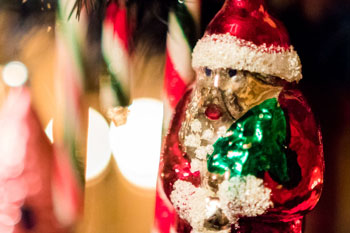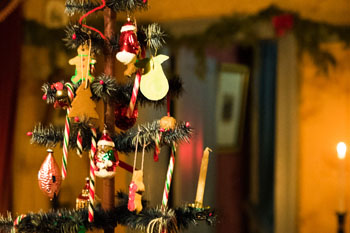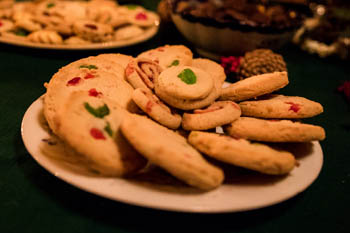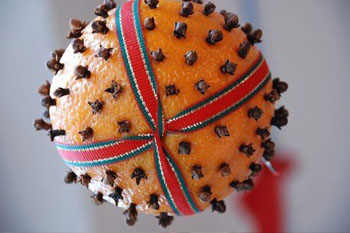Victorian Christmas
Woodside National Historic Site
Victorian Christmas
Christmas in the 1890s was a joyous festival of light, colour, sounds and smells. Much of what is regarded today as Christmas custom was popularized by Victorians, who included various traditions in their celebration of the Yuletide. The giving of gifts, the Christmas tree, its decorations and seasonal food can all be traced back to different cultures. The royal families of Europe, fashion magazines and retail giants influenced the character of Christmas celebrations.
Christmas gifts

The giving of gifts was not widely popular in English-speaking countries until the nineteenth century, when people in England and America began to exchange small articles on Christmas Day. In the 1850s magazines were advertising Christmas gifts to purchase, but ladies’ journals of the 1880s encouraged their readers to make gifts such as embroidered purses, beaded pockets, pen wipers and card cases.
Christmas became more commercialized in the 1880s and ‘90s. Advertisements in the Toronto Globe of 1890 suggested gifts of fur coats and capes, jewellery, eiderdown quilts and carpet sweepers. In an announcement on December 15, 1890, the Toronto Eaton’s Store advised customers to shop as early as 8 o’clock in the morning, claiming that “this week and next will find us extremely active . . . with hundreds of extra helpers.” Another Toronto store offered a free turkey to patrons of any article worth $7.50.
By the 1890s, Christmas had become somewhat secularized, with house decorations, Christmas trees, gifts, stockings and a jolly, fat Santa Claus. In origin a Christian saint, Santa Claus evolved rapidly in the nineteenth century. Clement C. Moore created the character of a jolly, red-cheeked Father Christmas in ‘Twas the Night Before Christmas (1822); and the illustrations of Thomas Nast (1860s-1880s) formed the basis of our modern image of Santa Claus.
Like most families in the community of Berlin in 1890, the Kings celebrated Christmas. As the Kings were a devoutly religious family, the chief significance of Christmas to them was undoubtedly as a Christian feast. But there is also little doubt that Woodside, their Berlin residence, wore all the colour and glitter of the season. Each child in the King family was given $2.50 with which to buy gifts, and very extensive consideration was given to the selection of each present. “I can recall,” wrote Mackenzie King in 1949, “buying little Christmas presents for members of the family. I remember the anxiety occasioned in these expenditures. I recall securing for my mother a card case covered with diamond-shaped mother of pearl at Fox’s Jewellery Store. I can see the interest Mr. Fox took in my making the purchase. I was the height of the counter. I thought I had secured something fine.”
The Christmas tree

The Christmas tree was the main attraction and decoration during the Yuletide season. The use of greenery as decoration can be traced back to pagan origins, but eventually Christianity adopted the custom. Christmas trees have been recorded as far back as the 1500s in Germany. In fact, most of our Christmas traditions involving the tree and its decoration are of German origin.
The tree became popular in the English-speaking world when Queen Victoria and Prince Albert erected a Christmas tree at Windsor Castle. In 1848, an illustration in the London Illustrated News pictured Queen Victoria, Prince Albert and family around a decorated tree. As a result, Christmas trees became the fashion.
The tree was usually placed upon a table, with the gifts arranged around its base. References to floor-to-ceiling trees can be found in American publications of the 1870s, when it was popular to place the gifts among the branches of the tree.
The decorations were often homemade: popcorn and cranberry chains, cut-outs such as cardboard starts, little pot-pourris, cookies and cornucopias filled with sweets. Factory-produced cut-outs of angels, children and Santa Claus were very popular. Cotton batting was sometimes used on branches to imitate snow.
The introduction of the glass ornament in Germany around 1860 marked a new trend in decoration. Most of the glass decorations came from Lauscha, a small town where glass blowing was the primary support of most families. All the ornaments were hand blown, coloured and then sold by individual families to merchants. The first exported ornaments consisted mainly of glass icicles and balls. By the 189s the ornaments had evolved into finely crafted, multi-shaped decorations. F.W. Woolworth began mass importation during this period and did much both to boost this industry in Germany and to influence the trend of decorating in North America. In the 1890s, a family would purchase one or two ornaments per year to add to the collection. It is interesting to note as well that ornament hooks were an invention of the 1890s.
Candles were carefully fixed onto the tree with clips, so that nothing was too close to the flame. Light provided much of the magic for the tree, but the candles would be lit for only a very short time. Another method of lighting the tree was with glass oil lamps containing water, a layer of oil and a floating wick.
Christmas foods

Although the Yuletide was known for centuries as a time of feasting, Victorians were largely responsible for popularizing this feast. Roast beef and goose were favourite entrées, but by the late nineteenth century turkey was becoming popular. It is interesting, however, to note this advice in a ladies’ magazine: “When turkey is twenty-five cents a pound . . . chicken at sixteen or eighteen cents a pound may be prepared in a way almost to make people suppose that they are eating Christmas turkey.”
Vegetables on the Yuletide menu were those most common to the winter months – potatoes, sweet potatoes, turnips, carrots and onions. Oysters were readily available and were used in soup and as stuffing for the turkey. Oranges and apples were popular as stocking stuffers and as seasonal centrepieces.
Christmas desserts have a popularity all their own. Christmas pudding and mince pie have a very long tradition. The original mince pie was made of meat and gravy, but in less well-off households meat was replaced by raisins, currants, fruits and berries. The puddings, which came in a variety of shapes and kinds, were often served with a brandy sauce and were the highlight of the meal. Queen Victoria arranged for each member of her household staff to receive a pudding for the Christmas season.
Victorian Christmas: a time of feasting and family. Our Victorian ancestors loved this festive season. To us in the twentieth century they passed on both their love for Christmas and their joyful traditions.
A seasonal recipe
Rich soft gingerbread
- 1 cup butter
- 2 eggs
- 1 cup sugar
- 1 teaspoon soda
- 1 small cup molasses
- 1 teaspoon each of ginger and salt
Make a stiff dough with flour, and bake in a square tin. Add approximately 3 cups of flour, bake at 350 degrees F. for about 40 minutes.
Orange sauce
Use 1 cup hot water, 1 cup sugar, 2 cups butter, 1 heaping tablespoon of cornstarch wet in the strained juice of 2 acid oranges (the red, or blood oranges are the best.)
Boil the water, sugar and orange peel until the sugar is dissolved; then add the cornstarch and orange juice and let boil until it thickens; take out the orange peel and add the butter, with 1 saltspoon of salt; stir well together, and serve.
Source: "Smiley's Cookbook and Universal Household Guide", 1894
A seasonal craft

How to make a Pomander
- Using a straight pin, prick the skin of a medium-sized orange and insert a clove. Repeat until the orange is densely covered in cloves. For variation, use cloves to create a pattern or design. (If any orange skin is exposed, omit step #2.)
- Roll your covered pomander in a mixture of cinnamon, nutmeg and allspice (1 tbsp each) to enhance its scent.
- Add 1 tsp. dried orris root to prevent mold.
- Place in a paper bag and store in a cool place for approximately one month until it has dried out. Your pomander should sound hollow and feel lightweight. Refresh with spice mixture.
- Adorn with ribbon to hang or display in a bowl.
Admire the festive pomanders at Woodside.
© Etsy.com via "Layla". Used with permission, 2010
Related links
- Date modified :